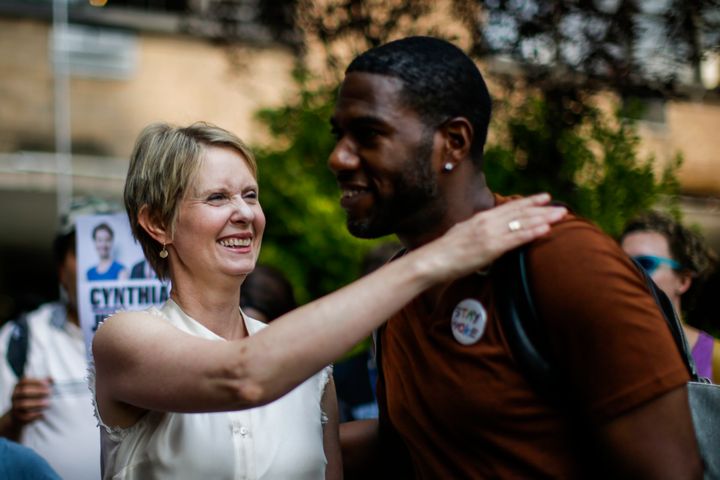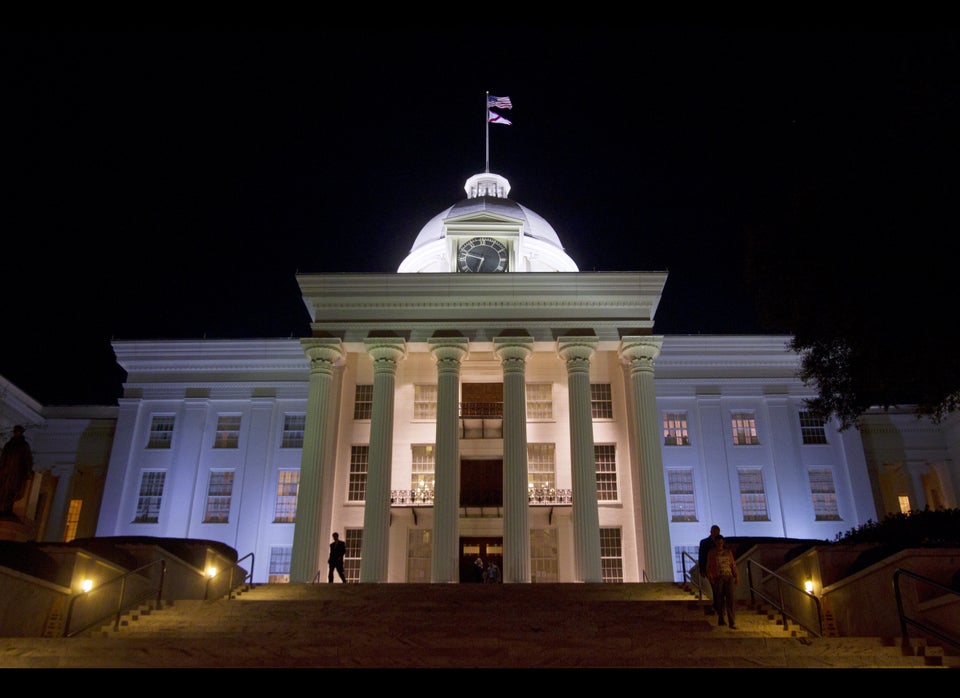
BROOKLYN, N.Y. — The temperature easily exceeded 90 degrees in the cramped and humid Ancient Light Studio in the Bedford-Stuyvesant neighborhood.
But the sticky heat was not enough to deter the group of 75 people, mostly black women, from filing into the unglamorous venue on the evening of Aug. 15 to learn more about New York gubernatorial hopeful Cynthia Nixon, a former actress and education activist, and her plans to address the crisis of black maternal mortality.
Before Nixon’s arrival, attendees picked at the chips and dip on a folding table in one of the community space’s two rooms. The red-white-and-blue “Cynthia for NY” cards on a table by the entrance did double duty as makeshift personal fans — a necessary relief in the muggy space.
Jamilah Lemieux, a prominent black writer Nixon hired as an adviser in July, introduced Nixon and conducted a 10-minute discussion with her about addressing black maternal mortality and racial justice more broadly. It was a way of acquainting black women with a progressive insurgent who desperately needs their votes and wants them to know she cares about the issues that matter most to them.
“It seems to me the question should be, ‘Why isn’t racial justice at the center of every campaign?’”
- Cynthia Nixon
The conversation had its fair share of predictable crowd pleasers. When Lemieux asked why racial justice was “at the center” of Nixon’s campaign, Nixon replied, “It seems to me the question should be, ‘Why isn’t racial justice at the center of every campaign?’” The audience applauded.
But at other times, Nixon navigated the tricky waters of intersectional politics with fluency. She was well versed enough in policy to appreciate — and note repeatedly — that the higher rates of black maternal and infant mortality cannot be explained by disproportionate incidence of poverty among black people. Although income and education influence outcomes, racial disparities persist within categories: A baby born to a black woman with an advanced degree is about as likely to die as a baby born to a white woman with an eighth-grade education.
And in New York City alone, black women are more than 12 times as likely as white women to die as a result of pregnancy, Nixon said, prompting audible gasps and a cry of “Jesus” from the audience.
“That’s not just a crisis. That’s an epidemic,” she said.
Nixon did not offer much in the way of new policy prescriptions. In a rare bit of détente, she praised the work of her primary opponent — Gov. Andrew Cuomo (D) — on the issue and promised to expand on it. In April he announced the creation of a maternal mortality task force to improve outcomes and a review board to examine the causes of every maternal death.
But the event was significant because of what it represented: A white, unabashedly left-wing candidate holding an event on an issue of particular importance to black women; pointing the finger at institutional racism, rather than class divisions; and showing her willingness to listen to black women.
In fact, after Nixon spoke, she literally took to the floor for a panel discussion of four reproductive justice experts who answered questions about black women’s health and racial disparities in health care from Lemieux and women in the audience. Photos of her seated humbly on the ground to listen to the panel went viral on social media.
The event reflected a defining characteristic of Nixon’s underdog bid: Relentlessly courting voters in New York’s communities of color, which play a pivotal role in the state’s Democratic primaries.
The failure of progressive outsiders to break through in the urban black demographic in particular has prevented them from gaining a stronger foothold in New York politics and across the country.
In 2014, when Fordham University law professor and anti-corruption activist Zephyr Teachout challenged Cuomo from the left, she performed unexpectedly well upstate, enabling her to pick up more than one-third of the primary vote on a shoestring budget. Had Cuomo not racked up such high margins in the more diverse area in and around New York City, Teachout might have been able to unseat him.
Nixon’s outreach to voters of color, particularly in New York City, aims to win over these voters — or at least limit her losses — in a way that Teachout and Vermont Sen. Bernie Sanders, who lost New York’s 2016 Democratic presidential primary to Hillary Clinton, never managed to do.
In addition to Lemieux, Nixon hired Brooklyn NAACP President L. Joy Williams as a senior adviser and made racial equality — in criminal justice, education and housing policy — key themes of her campaign.
“The theme of the event was ‘listening to black women,’ and I think she gets that.”
- Tanisha Green
It’s a strategy that has been apparent in Nixon’s itinerary as well as her rhetoric. Nixon kicked off her campaign at a black church in Brooklyn’s Brownsville neighborhood in March; the day after the maternal mortality panel, she joined Jumaane Williams, a city councilman running for lieutenant governor, at an event rolling out her universal rent control plan in central Brooklyn’s heavily African-American Ebbets Field public housing development. And when championing marijuana legalization, Nixon is fond of noting that the drug is already “effectively legal for white people.”
Nixon’s message appears to resonate with those who hear it — not least, many of the black women who braved the heat to hear her speak in Bedford-Stuyvesant.
Tanisha Green, a nursing assistant and psychology doctoral student, had already decided she was not voting for Cuomo when she entered the Ancient Light Studio that day. Among other grievances, she was frustrated that the strict eligibility rules of the two-term governor’s supposedly free college program precluded her son from attending the State University of New York at Purchase tuition-free.
Nixon, however, still had to earn Green’s vote — and by the end of the event, the former “Sex and the City” star had.
“The theme of the event was ‘listening to black women,’ and I think she gets that,” Green said. “I don’t know if she always got that, but I think that she gets that it’s not just lip service — you really have to listen to us and include us.”
Nixon’s stands for the elimination of cash bail and other criminal justice reforms has also earned her the support of black civil rights activist Akeem Browder. His brother Kalief Browder took his own life at 22, after three years awaiting trial in jail on Rikers Island, most of it in solitary confinement.
(Cuomo, by contrast, has backed ending cash bail only for select crimes.)
But there are still precious few signs that Nixon has made a dent in Cuomo’s support with black voters, let alone in the primary electorate at large. On Monday the final public poll before the Sept. 13 election showed Cuomo leading Nixon statewide by 41 percentage points. Cuomo held his biggest lead among black primary voters, 84 percent of whom said they planned to vote for him.
It’s an advantage that has contributed to Cuomo’s lead inside the vote-rich borders of New York City, where he is ahead by 50 points.
“These polls talk to very few black voters,” said Nixon campaign spokeswoman Lauren Hitt. “They tend to make up just 20 percent of a sample of 500 voters — so the margin of error within that even smaller sample of black voters is huge. Given that the polls in general have been pretty off this year, it’s hard to put any stock in that.”

An Incumbent With A Popular Father
The same powers of incumbency that have helped Cuomo with the broader electorate have solidified his hold on the black electorate. He has raised $36.5 million, which enables him to build on already widespread name recognition through television ads. Nixon, by contrast, has raised a mere $2.5 million, effectively putting TV airtime out of reach.
And when Cuomo has visited predominantly black neighborhoods in New York since the start of the campaign, he has brought the power of the purse strings with him. At a press conference in Brownsville in July, he touted plans for 32 new community health centers in central Brooklyn. On Wednesday he went to the site of an old landfill on Jamaica Bay in Brooklyn to announce increased state investment in the forthcoming development there of what will be the largest state park in New York City. The park, he revealed on Wednesday, is to be named after Shirley Chisholm, a central Brooklynite who became the nation’s first black congresswoman in 1968 and ran for president in 1972.
Thanks to Cuomo’s influence and well-earned reputation for vindictiveness, Jumaane Williams is one of only two black elected officials in the state — along with Tiffany Garriga, a town council member from Hudson — to endorse Nixon.
Cuomo is running on a slate with New York City Public Advocate Letitia James, a black woman running for attorney general.
Hoping for a similar boost, Nixon has run on a ticket with Williams, who shares her progressive ideology. There are some indications though, that voters — and key validators like The New York Times ― are assessing their candidacies independently.
Regina Wheelock, a retired school safety officer, attended the Nixon-Williams rally at Ebbets Field Houses, where she lives. Wheelock said she plans to vote for Williams, whom she remembers from his youth, but still has to do more research on Nixon.
Like Williams, Andrew Cuomo is more of a known entity for Wheelock. “I knew his father,” she said, referring to former Gov. Mario Cuomo. “I never was a political person, but his father spoke at my graduation.”
“Black people have a reasonable relationship with the Cuomos ― him and his dad.”
- Leah Daughtry
Andrew Cuomo enjoys the support of many black voters who had a warm relationship with his late father.
“Black people have a reasonable relationship with the Cuomos ― him and his dad,” said Leah Daughtry, an African-American pastor and Democratic Party official from Brooklyn, who recalled her father’s friendship with Mario Cuomo. She has not publicly endorsed anyone in the race, but she added, “It’s hard for me to conceive of not voting for Andrew, because of the familial relationship.”
Perhaps the biggest obstacle to Nixon’s campaign is her lack of experience at a time when Democratic primary voters are furious about that flaw in President Donald Trump.
Nick Haby, a marketing professional and LGBT rights activist who runs her canvassing operation in Astoria, said that the Nixon skeptics he has met often unfavorably link her celebrity and the president’s.
“We don’t want to try that again,” they say, according to Haby, who tries his best to convince them otherwise.
Robert Green, who was impressed with a speech Nixon gave at St. Luke’s A.M.E. Church in Harlem on Sunday morning, had a different but related concern. His mother was close to the elder Cuomo, and Green said he is leaning toward voting for Andrew Cuomo on Thursday. Given Nixon’s lack of political experience, he said he had his doubts about her ability to stand up to the president.
“She has a lot to say, but you gotta be realistic,” Green said. “This is Trump going around town now, and I do not like him.”
CORRECTION: An earlier version of this story incorrectly stated that Letitia James would be the first female African-American state attorney general.

